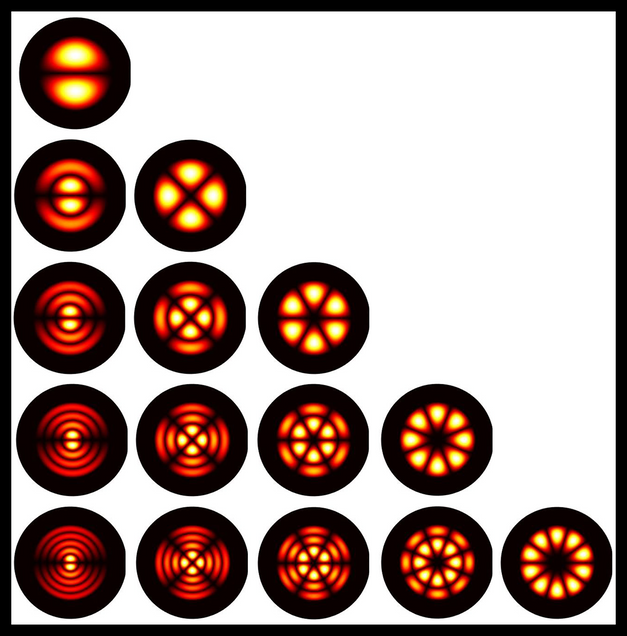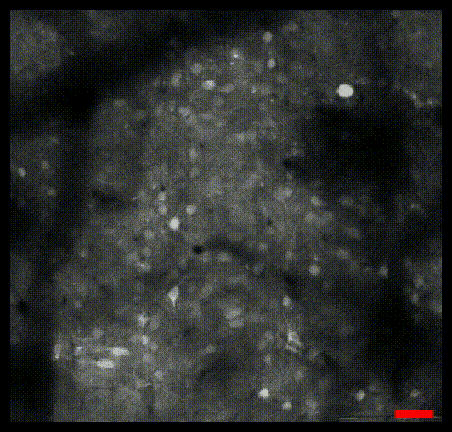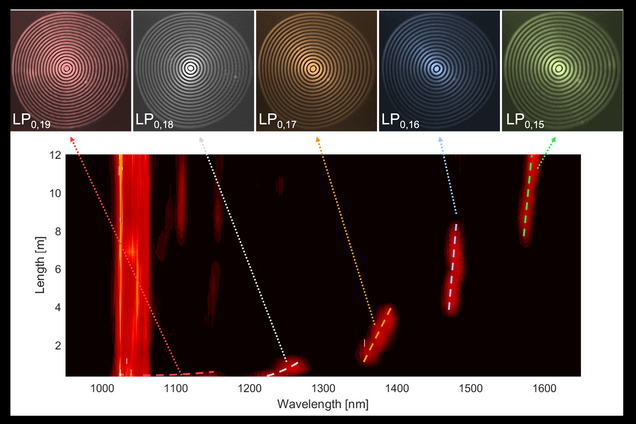Research



Physics & Applications of Singular Light
When we think of light, we think of a Gaussian-shaped spot, usually traveling in a straight line except when it encounters interfaces. This is, however, only the first, fundamental solution of the wave equation – much as a guitar string can have many modes (and frequencies) of vibrations, so can light also exist in different eigenstates. These peculiarly shaped light beams are characterized by singularities – i.e., regions in which some quantity does not have a well-defined value – in polarization, phase or amplitude. The physics of propagation of such beams reveals exotic effects, such as the ability of the beam to self-heal past obstructions (Bessel beams), the ability to carry orbital angular momentum (OAM) that makes light travel in helical paths rather than a straight line, or even the possibility of retaining memory of the paths that it takes. Analogous to the physics of tornadoes as well as electron orbitals, these beams reveal several unique classical and quantum properties not normally observed with conventional Gaussian beams. We study these fundamental properties and also apply them to varied applications such as high-capacity classical communications that consume low energy per bit, high-speed metrology including object sensing for autonomous systems as well as spectrometry and imaging.
Representative Publications
- Z. Ma, P. Kristensen and S. Ramachandran, “Scaling information pathways in optical fibers by topological confinement,” Science 380, 278-282 (2023).
- Z. Ma and S. Ramachandran, “Propagation stability in optical fibers: role of path memory and angular momentum,” Nanophotonics 10, 209 (2021).
- A. P. Greenberg, G. Prabhakar, and S. Ramachandran, “High resolution spectral metrology leveraging topologically enhanced optical activity in fibers,” Nature Communications 11, 5257 (2020).
- P. Gregg, P. Kristensen, A. Rubano, S. Golowich, L. Marrucci and S. Ramachandran, “Enhanced Spin Orbit Interaction of Light in Highly Confining Optical Fibers for Mode Division Multiplexing,” Nature Communications 10, 4707 (2019).
- D. Cozzolino, D. Bacco, B.D. Lio, K. Ingerslev, Y. Ding, K. Dalgaard, P. Kristensen, M. Galili, K. Rottwitt, S. Ramachandran, L.K. Oxenløwe, “Orbital Angular Momentum States Enabling Fiber-based High-dimensional Quantum Communication,” Phys. Rev. Applied 11, 064058 (2019).
- D. L. P. Vitullo, C.C. Leary, P. Gregg, R.A. Smith, D.V. Reddy, S. Ramachandran and M. G. Raymer, “Observation of Interaction of Spin and Intrinsic Orbital Angular Momentum of Light,” Phys. Rev. Lett. 118, 083601 (2017).
- B. N. Tugchin, N. Janunts, M. Steinert, K. Dietrich, D. Sivun, S. Ramachandran, K.V. Nerkararyan, A. Tünnermann, T. Pertsch, “Controlling the excitation of radially polarized conical plasmons in plasmonic tips in liquids,” RSC Advances, 6, 53273 (2016).
- A. E. Willner, H. Huang, Y. Yan, Y. Ren, N. Ahmed, G. Xie, C. Bao, L. Li, Y. Cao, Z. Zhao, J. Wang, M. P. J. Lavery, M. Tur, S. Ramachandran, A. F. Molisch, N. Ashrafi, and S. Ashrafi, “Optical communications using orbital angular momentum beams,” Invited Paper, Adv. Opt. Photon. 7, 66 (2015).
- N. Bozinovic, Y. Yue, Y. Ren, M. Tur, P. Kristensen, H Huang, A.E. Willner, and S. Ramachandran, “Terabit-Scale Orbital Angular Momentum Mode Division Multiplexing in Fibers,” Science 340, 1545 (2013).
Spatio-temporal & Ultra-fast Microscopy
Optical imaging techniques such as fluorescence, confocal, or multiphoton microscopy, have allowed scientists to study the properties and function of living biological tissues, such as the mammalian brain. However, refractive index inhomogeneity in living tissue leads to scattering of input light fields, which reduces the penetration depth at which useful information about the sample can be gleaned. We aim to study how tailoring of nonlinear interactions between ultra-fast pulses of light – both inside and outside of biological samples – can be used to enhance signals from deep within the tissue. Furthermore, we study how the use of structured light – i.e. light with spatial profiles more complex than a conventional Gaussian beam – can be used to improve information throughput in biological imaging in order to develop state-of-the-art microscopy methods for neuroscience and life science at large.
Representative Publications
- J. Demas, J. Manley, F. Tejera, K. Barber, H. Kim, F. M. Traub, B. Chen, and A. Vaziri, “High-speed, cortex-wide volumetric recording of neuroactivity at cellular resolution using light beads microscopy,” Nature Methods 18, 1103 (2021).
- S. Weisenburger, F. Tejera, J. Demas, et al., “Volumetric Ca2+ Imaging in the Mouse Brain Using Hybrid Multiplexed Sculpted Light Microscopy,” Cell 177, 1050 (2019).
- L. Rishøj, B. Tai, P. Kristensen, and S. Ramachandran, “Soliton self-mode conversion: revisiting Raman scattering of ultrashort pulses,” Optica 6, 304 (2019).
- L. Yan, P. Kristensen, S. Ramachandran, “Vortex fibers for stimulated emission depletion (STED) microscopy,” APL Photonics 4, 022903 (2019).
- L. Yan, P. Gregg, E. Karimi, A. Rubano, L. Marrucci, R. Boyd and S. Ramachandran, “Q-plate enabled spectrally diverse orbital-angular-momentum conversion for STED microscopy,” Optica 2, 900 (2015).
Nonlinear & Quantum Photonics
Nonlinear optical phenomena represent the interaction of light with the material in which it propagates, resulting in myriad effects such as the ability to controllably alter its color and shape in both time and space. Because such effects perturb the principle of superposition in linear optics, nonlinear optics is one of the best known means of generating quantum entanglement. We study new nonlinear optical phenomena enabled by singular and structured light beams, such as new modal selection rules for Raman & Brillouin scattering and the ability to obtain hyper- or hybrid-quantum entanglement. We then exploit these unique effects for applications such as single-photon frequency conversion for quantum networks, and for developing high-power lasers in the long-pulse as well as ultra-fast regime, for myriad uses ranging from biomedical imaging to LIDAR-based sensing and underwater communications.
Short Course by Prof. Ramachandran on Multimode Nonlinearities
Representative Publications
- A.P. Greenberg, Z. Ma, and S. Ramachandran, “Angular momentum driven dynamics of stimulated Brillouin scattering in multimode fibers,” Opt. Express 30, 29708-29721 (2022)
- Ilaria Cristiani et al, “Roadmap on multimode photonics,” Invited Paper, Opt. 24, 083001 (2022).
- X. Liu, Z. Ma, A. Antikainen, S. Ramachandran, “Raman gain control in optical fibers with orbital-angular-momentum-induced chirality of light,” Opt. Express 30, 26967-26974 (2022)
- H. B. Kabagöz, A. Antikainen, and S. Ramachandran, “Passive, controllable generation of energetic multi-color pulses via spatial mode re-organizations in optical fibers,” APL Photonics 6, 126109 (2021).
- R. Lindberg, X. Liu, A. Zukauskas, S. Ramachandran and V. Pasiskevicius, “Simultaneous nonlinear wavelength and mode conversion for high-brightness blue sources,” J. Opt. Soc. Am. B 38, 3491 (2021)
- X. Liu, E.N. Christensen, K. Rottwitt and S. Ramachandran, “Nonlinear four-wave mixing with enhanced diversity and selectivity via spin and orbital angular momentum conservation,” APL Photonics 5, 010802 (2020).
- G. Prabhakar, P. Gregg, L. Rishoj, P. Kristensen, and S. Ramachandran, “Octave-wide supercontinuum generation of light-carrying orbital angular momentum,” Opt. Express 27, 11547-11556 (2019).
- L. Rishøj, B. Tai, P. Kristensen, and S. Ramachandran, “Soliton self-mode conversion: revisiting Raman scattering of ultrashort pulses,” Optica 6, 304-308 (2019).
- M. Ordu, J. Guo, G.Ng Pack, P. Shah, S. Ramachandran, M.K. Hong, L.D. Ziegler, S.N. Basu and S. Erramilli, “Nonlinear optics in germanium mid-infrared fiber material: Detuning oscillations in femtosecond mid-infrared spectroscopy,” AIP Advances 7, 095125 (2017).
- J. Demas, P. Steinvurzel, B. Tai, L. Rishøj, Y. Chen, and S. Ramachandran, “Intermodal nonlinear mixing with Bessel beams in optical fiber,” Optica 2, 14 (2015).